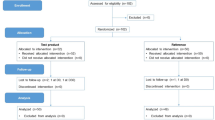Abstract
Background and objective: Sertaconazole, an imidazole antifungal drug, has been proven to have broad and potent antifungal activity. In the present study, the pharmacokinetics of sertaconazole nail patches, developed for treatment of onychodystrophy and onychomycosis, were investigated in healthy volunteers. The objective of the study was to investigate the penetration of sertaconazole into the nail and plasma and the residual sertaconazole concentration in patches after 1 week of application onto the nails.
Methods: In a double-blind study, 16 healthy adults were treated with a 2.2cm2 nail patch containing sertaconazole 3.63mg and another patch containing no antifungal agent, which were placed on the left and right thumbnail of each subject, respectively (or vice versa), in a randomized order. The treatment period was 6 weeks and the patches were replaced weekly. Nail clippings, used nail patches, and blood samples were investigated to determine sertaconazole concentrations.
Results: Sertaconazole was detected in all sertaconazole-treated nail samples with mean concentrations of >100 μg/g, which exceeds the minimum inhibitory concentrations (MICs) for all relevant fungi in this context. Measurements of the residual dose in the patches suggested that 16–71% of the active ingredient had penetrated into the nail. No plasma sertaconazole concentrations could be detected.
Conclusion: By virtue of their positive influence (occlusion) on water and lipid metabolism in dystrophic nails, nail patches should have beneficial therapeutic effects in onychodystrophic conditions. Addition of the antifungal agent sertaconazole adds broad-spectrum antimicrobial activity. In this study, the concentrations of sertaconazole in the nails were shown to be well above the MIC values for pathogenic fungi relevant to onychomycosis. No systemic absorption of the active ingredient was detectable, which should exclude unwanted systemic effects of the drug.




Similar content being viewed by others
Notes
The use of brand names is for product identification purposes only and does not imply endorsement.
References
Sais G, Jucgla J, Peyd J. Prevalence of dermatophyte onychomycosis in Spain: a cross-sectional study. Br J Dermatol. 1995; 132: 758–61
Heikkila H, Stubb S. The prevalence of onychomycosis in Finland. Br J Dermatol. 1995; 133: 699–703
Elewski BE, Charif MA. Prevalence of onychomycosis in patients attending a dermatology clinic in north western Ohio for other conditions. Arch Dermatol 1997; 133: 1172–3
Summerbell RC, Kane J, Krajden S. Onychomycosis, tinea pedis and tinea manum caused by nondermatophyte filamentous fungi. Mycoses. 1989; 32: 609–19
Palacin C, Sacristan A, Ortiz JA. In vitro activity of sertaconazole. Arzneim-Forsch/Drug Res. 1992; 42: 699–705
Agut J, Palacin C, Sacristyn A, et al. Inhibition of ergosterol synthesis by sertaconazole in Candida albicans. Arzneim-Forsch/Drug Res. 1992; 42: 718–20
Guitèrez EQ. Phase III multicentre study to evaluate the efficacy and safety of 2% sertaconazole cream in comparison with 2% miconazole cream in patients affected by fungal infections of the skin. J Fur Acad Dermatol Venereol. 1993; 2 Suppl. 2: 82–6
Pedragosa P. Therapeutic efficacy of the new antimycotic sertaconazole in the treatment of cutaneous dermatophytosis. Arzneim-Forsch/Drug Res. 1992; 42: 689–74
US Department of Health and Human Services, Food and Drug Administration. International Conference on Harmonisation; good clinical practice: consolidated guideline; notice of availability. Federal Register. 1997 May 9; 62 (90): 25691–709
Establishment and validation of a bioanalytical method for the validation of sertaconazole in human nail. Neuss, Germany: FOCUS Clinical Drug Development GmbH, 1999 (Data on file)
Establishment and validation of a bioanalytical method for the determination of sertaconazole in human plasma. Neuss, Germany: FOCUS Clinical Drug Development GmbH, 1999 (Data on file)
Carrillo-Munoz AJ, Guglietta A, Palacin C, et al. In vitro antifungal activity of sertaconazole compared with nine other drugs against 250 clinical isolates of dermatophytes and Scopulariopsis brevicaulis. Chemotherapy. 2004; 50: 308–13
Drouhet E, Dupont B. In vitro antifungal activity of sertaconazole. Arzneim-Forsch/Drug Res. 1992; 42: 705–10
Kronauer C, Gfesser M, Ring J, et al. Transonychial water loss in healthy and diseased nails. Acta Dermatol Venereol. 2001; 81: 175–7
Hollmann J, Melnik BC, Lee MS, et al. Stratum corneum and nail lipids in patients with atopic dermatitis: decrease in ceramides — a pathogenetic factor in atopic xerosis? [in German]. Hautarzt. 1991; 42: 302–6
Zaun H. Brittle nails: objective assessment and therapy follow-up [in German]. Hautarzt. 1997; 48: 455–61
Ständer H, Ständer M, Nolting S. Incidence of fungal involvement in nail psoriasis [in German]. Hautarzt. 2001; 52: 418–22
Acknowledgments
This study was sponsored by Trommsdorff Arzneimittel GmbH & Co KG (Alsorf, Germany) which employs Dr Rudy Susilo and Dr Uwe Phillip Strauss in its Research & Development Department, who thereby have an interest in this publication. Dr Wolfgang Greb works for FOCUS Clinical Drug Development GmbH, the clinical research organization that conducted the actual study. Dr Hans C. Korting has collaborated with the sponsor company, Trommsdorff GmbH, in terms of advice and communications about the product.
Author information
Authors and Affiliations
Corresponding author
Rights and permissions
About this article
Cite this article
Susilo, R., Korting, H.C., Greb, W. et al. Nail Penetration of Sertaconazole with a Sertaconazole-Containing Nail Patch Formulation. Am J Clin Dermatol 7, 259–262 (2006). https://doi.org/10.2165/00128071-200607040-00007
Published:
Issue Date:
DOI: https://doi.org/10.2165/00128071-200607040-00007




